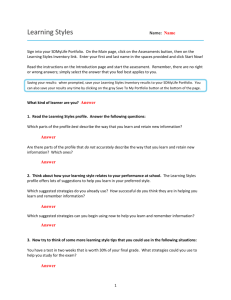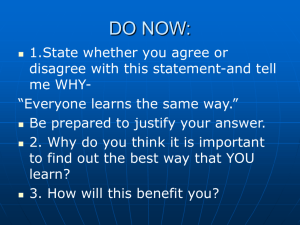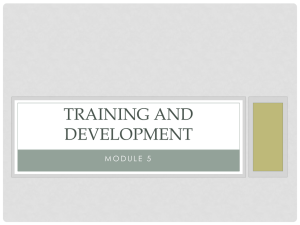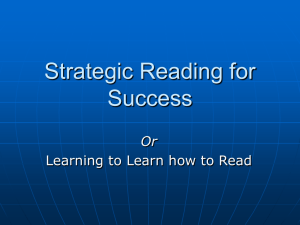What we will cover - Productive Living Board
advertisement
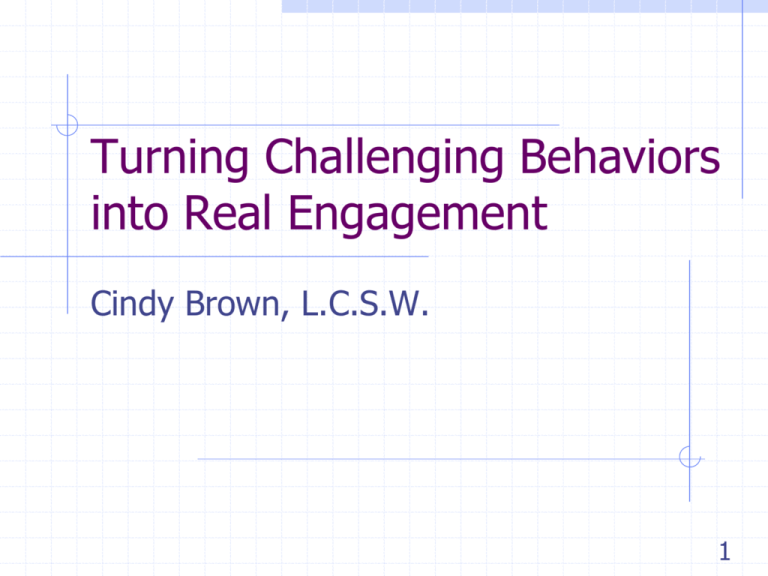
Turning Challenging Behaviors into Real Engagement Cindy Brown, L.C.S.W. 1 Introductions Your name Current position / years in the position Optional: Briefly tell us of a time in which you were fully engaged 2 What we will cover: Learn strategies to engage rather than only gain compliance Add new tools to your tool box when working with challenging behaviors Learn redirection and other therapeutic interventions to implement change 3 What you want to learn today 4 The Change Cycle Old Behavior Desired Behavior Energy Shock COMPLIANCE Denial Excitement Average Productivity Anger Engagement Frustration Confusion Listlessness Apathy Neutral Zone - Transition - Time 5 Why do individuals follow behavior plans and PCPs ? For money / for rewards /Tangibles Approval / affiliation / social attention To escape punishment To avoid shame, blame or judgment To avoid guilt Out of ‘duty’ / ‘Supposed to’ Out of obedience 6 Signs of Compliance* could be: Passive responding Following the “script” – no authoring Being dutiful Referencing outsiders for assurance and/or constant correction Pleasing others instead of self Aloft, agitated, annoyed, apathetic “If I comply…I will eventually defy”. * Act or process of conforming to official requirements; a disposition of yielding to others. 7 Indicators of Engagement* Owning the “how” or strategy Contributing to the “how” Eye contact Self-reporting Sustained changed behaviors Sense of personal energy assigned to the task * Observed, alert. To interlock with/mesh with; To bind oneself with a pledge or promise; to hold the attention of or physical involvement in. To 8 occupy completely; to be absorbed. Learning Styles Keep in mind that adult learners fall into different categories of preferred learning styles Visual Learners: Prefer color-coding, use of pictures, written instructions. Auditory Learners: Prefers buzzers, clapping, sounds, verbal instructions and praise. Kinesthetic or Experiential Learners: Prefers to experience things to learn them. Likes to move when learning. 9 9 Potential Barriers to Learning Limited Learning Capacity: Some individuals have significant limitations on how much they learn at one time. Try “chunking” tasks – clustering 2-3 steps at a time only. Teach with repetition. Processing Deficits: Some are easily distracted, need more time for a single activity or response. Match their pace. Slow pace. Don’t rush. Typical with persons with a brain injury. Short Attention Span: Some are easily distracted and can’t focus for extended time periods. Be prepared to have several different activities to do. Break activities into multiple sessions. 10 More Potential Barriers to Learning Difficulty in Seeing Cause& Effect Some individuals can’t grasp the concept that “If I do this, then this other thing will or will not happen.” Don’t count on them making the connection! Use visuals and sight cues between steps. Role play. Outer-Directed focus Some feel that they have no control over their lives. Their motivation is to follow.Teach decision-making in little steps. Point to areas they DO have control. Inability to Abstract Concepts, symbols, or Generalized abstractions can be difficult to understand. Use concrete examples. Teach in “real world” settings. Role model and relate concepts to the Individual’s life. 11 Still More Potential Barriers to Learning Limited Environmental Interaction : Because of a lack of past experience, a Individual may exhibit a lack of skills & confidence. Praise the Individual often! Take them out into new experiences as much as possible. Use every interaction and experience to encourage the use of all their senses and learning. Poor Self-Concept Sometimes Individuals have such a poor self-concept that they don’t believe they can do anything. Their motivation is low and they have a lot of fear of new things. Help them see the progress they are making in little things. Remind him or her of their successes. Short Memory Span Some things are not easily retained – even recent things! Repeat, repeat, repeat! Label everything! Use visual cues. Ask the individual to repeat back to you what was said. 12 Therapeutic Interventions Avoid the “Bait and Switch” Identify relevant goals Identify their comfort zone – lead baby steps outside it Premack Principle Embedding relevant choices Redirection Reflection and raising personal awareness Use “I feel” instead of “ You” 13 In conclusion • The Change Cycle affects everyone so it helps to notice where an individual may be within the change process. • We are wanting to achieve Engagement instead of Compliance so that change can be sustained. • Learning Styles and Learning Barriers impact one’s ability to achieve engagement. This requires us to: • Identify the best strategy which leverages their learning style and minimizes barriers. • Create and use teachable moments often & regularly. 14



